第60回公共政策セミナー
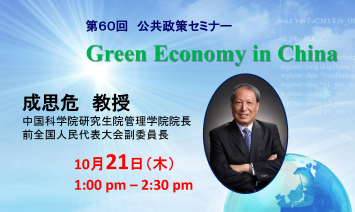
「中国におけるグリーンエコノミー」
“Green Economy in China”
成思危教授(中国科学院研究生院管理学院院長・前全国人民代表大会副委員長)
| 日 時 : | 2010年10月21日(木) 13:00~14:30 |
|---|---|
| 会 場 : | 東京大学本郷キャンパス 医学部教育研究棟13階第6セミナー室 |
| 司 会 : | 田中明彦(東京大学理事・副学長) |
| 言 語 : | 英語 |
10月21日(木)医学部教育研究棟第6セミナー室において、成思危中国科学院研究生院管理学院院長(前全国人民代表大会副委員長)による第60回公共政策セミナーが開催されました。
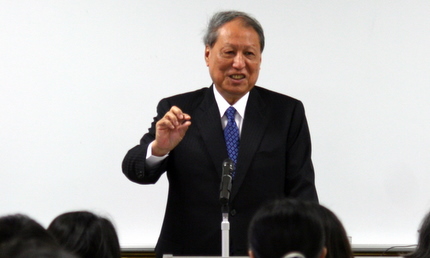
成思危教授(前全国人民代表大会副委員長)
Summary
Professor Cheng Siwei, Director of the Chinese Academy of Sciences' Research Center on Fictitious Economy & Data, delivered the keynote address - Green Economy in China - at the 60th Public Policy Seminar on October 21. Professor Akihiko Tanaka, Executive Vice President of The University of Tokyo, moderated the event. Graduate School of Public Policy dean Kuniaki Tanabe gave the opening remarks.
Professor Cheng began the seminar by saying, "Humans have historically been in awe of nature, and respectful of it." The industrial revolution however has led us to believe we can control and conquer nature. This is wrong, says Professor Cheng, and we are now seeing some of the consequences of our folly.
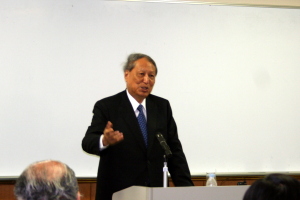 A "green economy," Professor Cheng continued, consists of three parts: a low carbon economy, a recycling economy, and an eco-economy. These combine to form what is often termed sustainable development, which in turn can be further defined as "the harmonious relationship between human beings and nature."
A "green economy," Professor Cheng continued, consists of three parts: a low carbon economy, a recycling economy, and an eco-economy. These combine to form what is often termed sustainable development, which in turn can be further defined as "the harmonious relationship between human beings and nature."
For a low carbon economy, we should: develop industries that do not emit carbon dioxide (such as alternative energy sectors, culture industries, etc); reduce emissions from existing industries; better utilize carbon dioxide, especially in the chemical industry; and further develop Carbon Capture and Storage (CCS) measures. The recycle economy must evolve around four R's - Recover, Reuse, Renew, and Recycle. This with allow for more efficient and balanced long-term sustainable development. And in terms of the eco-economy, we must continue to protect the ecological environment that we are all a part of.
Looking at China's energy source structure - 70% from coal, 20% from petroleum - Professor Cheng said that the PRC's green energy strategy consists of three parts: low pollution, low consumption, and low emission. According to Professor Cheng, a carbon cap is not appropriate for China at this time as it is still a developing economy. He noted how this is a similar outlook utilized by Japan in the 1960's and 1970's.
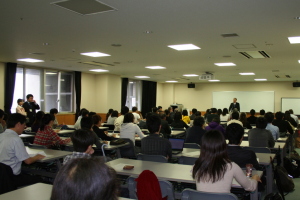 In order to support the development of a green economy, alternative energy sources must be better utilized and further developed. These sources include wind, solar, biofuels, hydro, nuclear, and clean coal. Indeed, China has a goal of increasing none-fossil energy usage to 15% (currently 9%) of total consumption by 2020, and was, according to Professor Cheng, the global leader in new energy technology investment in 2009. He continued by saying that as the past three industrial revolutions were led by the steam engine, electricity, and computers respectively, the fourth will be spearheaded by advancements in new energy.
In order to support the development of a green economy, alternative energy sources must be better utilized and further developed. These sources include wind, solar, biofuels, hydro, nuclear, and clean coal. Indeed, China has a goal of increasing none-fossil energy usage to 15% (currently 9%) of total consumption by 2020, and was, according to Professor Cheng, the global leader in new energy technology investment in 2009. He continued by saying that as the past three industrial revolutions were led by the steam engine, electricity, and computers respectively, the fourth will be spearheaded by advancements in new energy.
There are four pieces to this energy strategy puzzle, in light of China's status as a rapidly developing, young and large economy: political; economic; technological; and social.
China's participation in such international initiatives as the Kyoto Protocol or Copenhagen Accord must be understood under the premise that China will make energy-related policy decisions from a developing economy point of view. This by no means suggests that China will ignore its responsibilities as part of the global community, said Professor Cheng, but rather holding China to standards of a developed country is simply not appropriate.
The economics of a green economy create substantial problems for a developing country, as alternative energy resources are much more expensive than biofuels. Because of this, China needs to subsidize new energy consumers to help spur on the fledgling market. These subsidies should be reduced step by step, said Professor Cheng, in order to increase the incentives for alternative energy companies to further innovate and seek new levels of efficiency. Fiscal and monetary policy should also be utilized, not only in terms of subsidy allocation but also by introducing regulatory measures. Finally, China must develop its own carbon trade market, said Professor Cheng.
Technology advancement will play a critical role in China's efforts geared towards a green economy. Without technological breakthroughs, wind and solar power, along with adoption of advanced electrical smart grids, will be impossible in China. For this reason, Professor Cheng urged continued and increased government supported R&D be undertaken.
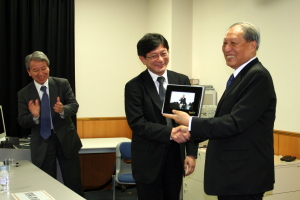
Last but not least is the social aspect of a green economy, said Professor Cheng. Society must be educated to the morality of sustainable living; the social consciousness of low carbon life should be encouraged.
Professor Cheng concluded by reemphasizing the importance of understanding a green economy not by how we can manipulate nature, but rather how humans and our environment can best exist in a harmonious relationship. This is the essence of sustainable development, and the correct way to understand movement towards a green economy.
関連項目
- ポスター (PDF, 1.39MB)
- 公共政策セミナー
